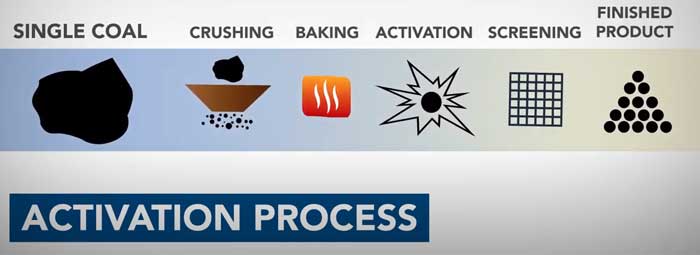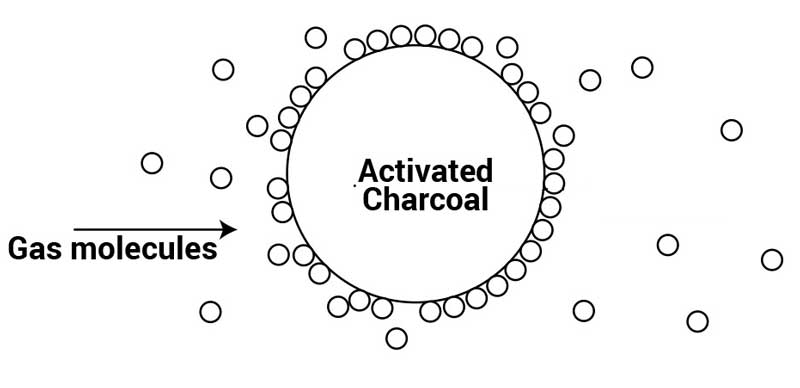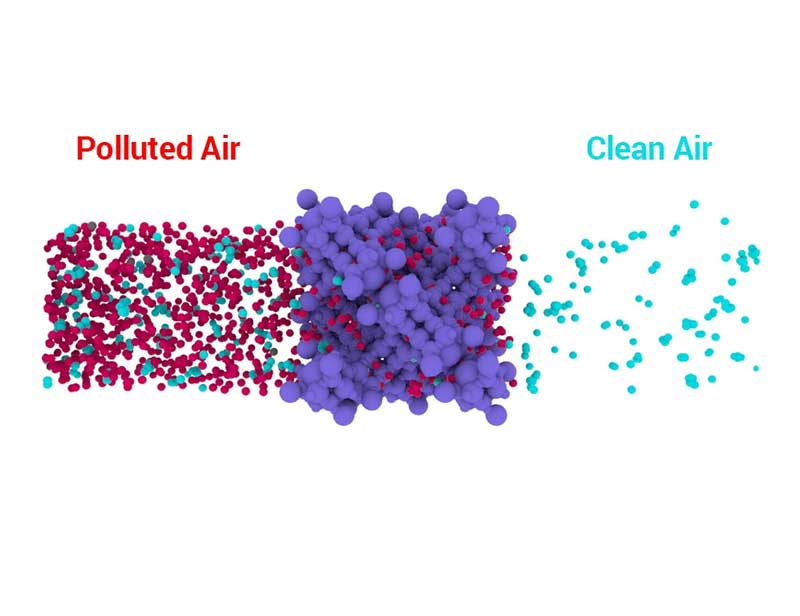What Is An Activated Carbon Filter
While shopping for an air purifier, you lot may have encountered the term activated carbon filter. Yous may also take learned that these filters can eliminate VOCs and odors from your indoor air but don't know how they work.
Below nosotros volition explain what activated carbon filters are and take a deeper expect into how information technology works.
- What Is An Activated Carbon Filter?
- How is Carbon Activated?
- How Does Activated Carbon Filter Work?
- Where Practice Carbon Filters Excel?
- Types of Activated Carbon Filters
- Factors Influencing Adsorption Capacity in Filters
What Is An Activated Carbon Filter?
An activated carbon filter is an air purification element consisting of a porous carbonaceous fabric sourced from carbon-rich plants similar wood, kokosnoot shells, and tree barks. It can also originate from lignite and bituminous coal.

This cloth is later taken through an activation procedure that makes information technology extremely porous. In fact, one gram of activated carbon tin can have a surface area of 500m2 and in a higher place. This gives it an exponential capacity to eliminate nigh airborne contaminants, including allergens and odors, with utmost efficiency.
How is Carbon Activated?
There are 2 methods for activating carbon:
Chemical Activation
Chemical activation involves preparing a bath of acid or chemicals and submerging the carbon into the liquid. The bath is heated to enhance its temperatures between 842°F and 1652°F (450 to 900 degrees Celsius).
This process is much quicker than gas treatment. However, circumspection is exercised as a lot of adsorption occurs in the heating chamber, resulting in an impure agile carbon. The carbon may besides be useless depending on the quantity of chemical adsorbed.
Gas Treatment
This activation method is accomplished past heating the carbon in a bedchamber while pumping gas. The process exposes the carbon material to oxygen for oxidation purposes. Gas treatment must occur in an inert surroundings whose temperature ranges between 1112°F and 1652°F (600-900 degrees Celsius).
The bedroom is consequently heated to raise the temperature to 1652°F-2192°F (900 and 1200 degrees Celsius). This process causes oxygen to bond to the carbon's surface, making it an excellent filter for cleaning air or water of pollutants.
How Does Activated Carbon Filter Work?
Activated carbon filters eliminate airborne contaminants through a procedure known every bit adsorption. Simply put, this procedure provides compounds with an attractive identify to reside rather than circulating in the air. Adsorption is often confused with absorption, only the two terms are different.

With absorption, the trapped substances are locked within the absorptive material. On the other hand, adsorption is a procedure through which the pollutants stick outside the carbon molecules.
This is where activation comes in handy; it increases the adsorption surface of the carbon molecules to maximize a filter's purification capacity.
Where Do Carbon Filters Excel?
Carbon filters are more often than not good at trapping tiny particulates measuring beneath 0.3 micrometers. As such, they are capable of cleaning gaseous pollutants.
Tobacco Smoke
Tobacco smoke contains over 7000 chemicals, with at least 250 of them adversely affecting human health, which is where carbon filters come in handy. Smoke particles measure betwixt 0.1 and 1 microns, meaning that they tin can laissez passer through a HEPA filter. This makes an activated carbon filter a must-have for people who smoke cigarettes or live with smokers.
Volatile Organic Compounds (VOCs)
VOCs ways molecular-level pollutants that are measured in Picometers, which are smaller than microns. These contaminants are then pocket-sized that they tin can remain airborne for a very long menstruum. The only way to remove them from your indoor air is through a high-end activated carbon filter.
VOCs are responsible for the lingering chemic odors you sometimes encounter in your home. Some of the commonly found VOCs in homes include:
- Acetaldehyde—Emanates from burning wood or tobacco products
- Benzene—This one has a sweet odour and commonly comes from paint thinners, cleaning products, and glues
- Chloroform—Comes from chlorinated products like bleach
- Formaldehyde—This chemical is introduced into your home via household items like piece of furniture and building materials
- Napthalene—Originates from mothballs
- Styrene—Stems from plastic packaging of appliances, toys, and furniture
- Trichloroethylen—Found in carpeting cleaners, varnishes, paints, and spot removers
Note: Ideally, you volition want to run your air purifier with an activated carbon filter every time you lot introduce something new into your home. It'south also advisable to run it after turning off your fireplace.
Odors
Thanks to their power to trap extremely tiny particulates, carbon activated filters are the perfect tools for eliminating that lingering bad odor from your abode. This makes air purifiers with carbon filters advisable for homes with pets, smokers, or mostly people who appreciate the smell of fresh air. They as well go a long way in eliminating unpleasant fragrances.

Types of Activated Carbon Filters
Beneath are four of the commonest activated carbon filters used in air purifiers:
Granular Activated Carbon
Also known as GAC, this filter consists of big granules with a 3mm bore, the size of minor rocks or sand. GAC filters have long service life and can be used in combination with other substances like zeolite. They're particularly suitable for eliminating odors and gaseous pollutants similar formaldehyde.
Powdered Activated Carbon
This filter consists of granules measuring 10 to 50 microns. These granules are bonded together with resins to create one large cake. Due to the smaller particles, this filter has a faster and higher adsorption capacity than its granular-activated counterpart.
Woven Carbon Filter
With this filter, activated carbon is woven into rayon fiber to create a cloth. This air cleaner manifests equally a thin canvass of carbon filter in your air purifier. It may besides come as a standalone unit that you lot can attach to areas requiring purification, including diaper disposal containers or kitchen waste bins.
Treated Carbon (Impregnation)
Sometimes, carbon is treated with potassium permanganate or silver to raise its adsorption capacity in a process popularly known as impregnation. Impregnated filters can eliminate a wider range of chemical gasses, such as natural gas and formaldehyde.
Factors Influencing Adsorption Capacity in Filters
While activated carbon filters are very effective in eliminating odors and gaseous pollutants from your indoor air, their efficiency is affected past the following factors:
Temperature
The platonic operating temperature for carbon filters is around 104°F (40 degrees Celsius). If the temperature goes too high, the adsorption charge per unit is adversely affected. On the flip side, high temperatures tin potentially cause desorption, a procedure through which the filter releases previously adsorbed pollutants.
Residence Fourth dimension
Residence fourth dimension is the menstruation taken past the air to pass through the carbon filter. This is when the filter adsorbs airborne contaminants; the duration should be as long as possible.
To maximize residence fourth dimension, the thickness of the carbon filter must exist sufficient, and the airflow speed should be kept at a minimum. This means that it's all-time to run your air purifier on the low fan setting.
Humidity
Relative humidity has a direct effect on the efficacy of a carbon filter. If your indoor RH levels go across lx%, the water molecules in the air will exist adsorbed, leaving limited infinite for the pollutants' adsorption.
To prevent this, avoid using your air purifier in overly damp rooms like bathrooms. It's also advisable to use a dehumidifier to maintain platonic RH levels in your indoor infinite. A wet extractor with a smart humidistat volition go a long style in ensuring that the relative humidity in your home doesn't go beyond the recommended level.
The Filter's Age
With continuous use, gaseous pollutants somewhen fill up up the adsorption sites, making the filter ineffective in trapping more contaminants. Suppose the available space fills up and yous fail to replace the filter. In that instance, the trapped chemicals with a high adsorption affinity volition disperse those with lesser affinity, causing them to recirculate into your indoor air. This is why you must observe carbon filters' shelf life.
Likewise, an improperly stored carbon filter could become less efficient with time as it continues to adsorb gases and humidity from the air. This makes it ineffective fifty-fifty before use. As such, it'south imperative to ensure that your replacement filter is fresh and properly stored.
-
- There'due south no perfect method for determining the right fourth dimension to replace your filter, but you may sometimes find a odor emanating from your air cleaner
- Yous won't necessarily become a sign; it's best to supercede your filter according to the manufacturer'south guidelines
- Besides, consider replacing the filter more than oft if your dwelling is exposed to a lot of pollutants
- Ideally, you may replace the filter once a month if your space has loftier levels of gaseous pollutants like VOCs, smoke, and odors.
Pre-Filters
A pre-filter comes in handy in protecting your activated carbon filter from particles that may crusade untimely clogging. As such, ensure that your air purifier comes with at to the lowest degree i superior-quality pre-filter, only more will be appreciated.
Key Takeaway
Activated carbon filters can eliminate more airborne pollutants than their conventional counterparts, which explains their rising popularity amidst homeowners.
These filters accept a high adsorption rate and hence the perfect selection for eliminating tiny particulates like VOCs, odors, and fume from your indoor air. Activated carbon filters can be used every bit standalone air cleaners. They can also be installed in air purifiers to ameliorate the machines' purification chapters.
What Is An Activated Carbon Filter,
Source: https://www.veranda-interiors.com/activated-carbon-air-filters
Posted by: oylerthervanable.blogspot.com


0 Response to "What Is An Activated Carbon Filter"
Post a Comment